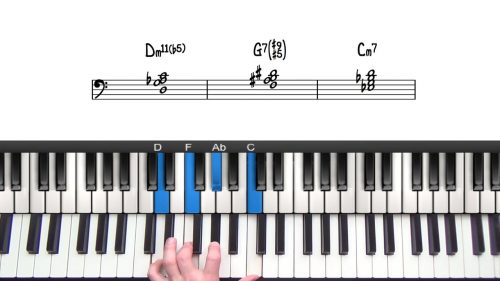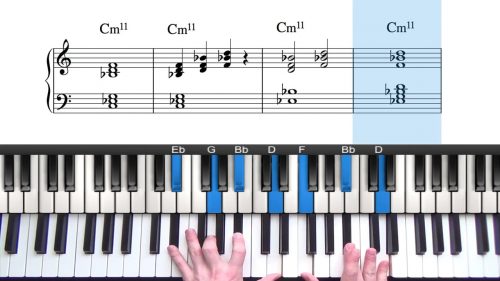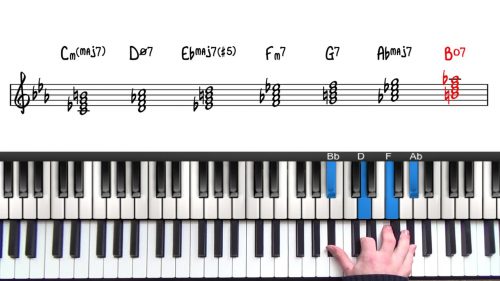Stella By Starlight Tutorial Part 2
In part of this tutorial we jump straight in with upper structure triads. These chords are particularly useful when there are upper extensions and alterations in the melody.
We cover a useful movement in major 251s to achieve and interesting version of the II-11 chord leading to a V7b9#11 with very smooth voice leading. I demonstrate this in 2 keys and recommend that you apply the formula to other keys in your practice time.
Next we look at a number of interesting rehamonisations. This tune is very commonly played and so adding in substitute chords is an effective way to spice up the chord changes.
We finish off by discussing a pedal point that can be used to transition from a downtempo variation of the tune, into a faster up tempo version. Pedal points are an effective tool to establish the change the feel or feel of an arrangement.







Hayden, another great tutorial as usual. This reharmonization at the beginning (the RH upper-structure sequence over the A-G in LH) reminds me a lot of what Herbie also does in the opening to the Miles tune “So What” on Kind of Blue. Check it out again – it’s a bit more elaborate there. Haven’t checked but I think the key is different, and he uses more upper-structure chords in the sequence. No idea how they would compute in terms of U-S voicings but it got me thinking that you could probably play chords right up the scale – C/Db/D/Eb etc. over a shell seventh chord – major or minor seventh – in the LH and each one would produce a different kind of alt7 chord. For example, with C-G-Bb in LH adding a B second inversion (F#-B-D#) would be a C7#11#9 (?!?). I have to go and play it now to see how it sounds!
Hi Martin, glad you enjoyed the lesson!
Yes it is similar. So What is a modal tune in D Minor, that moves up a half step to Eb Minor and repeats the same phrase.
The intro (I think it’s Bill Evans on that record) is similar to the tune in that a lot of the chords Bill uses are derived from D Dorian, and then Eb Dorian modes. I can hear lots of 2nd inversion triads which has that upper structure sound.
In a modal setting, yes you can play chords right up the scale, some will work better that others. Try it out with D Dorian Mode – all white notes – and move the same right hand structure up and down the scale.
Finally, with dominant upper structures, there are many combinations. The four most common and useful are the ones listed on the cheat sheet and covered in this lesson: pianogroove.com/jazz-piano-lessons/upper-structure-triads/
When you introduce diminished and augmented triads, you get many more combinations. I always recommend that students thoroughly learn the 4 most common, and internalise the sound they create… they all have a very different and unique sound. I rarely deviate away from these 4 upper structures, they have you covered for most dominant chords you will come across.
I posted a forum thread here: pianogroove.com/community/t/how-to-learn-upper-structures/944
Once thing to be mindful of with the B triad over C7, is that B is the major 7th, which will sound very dissonant over the b7 in your left hand – perhaps the most dissonant of all notes you could chose.
That doesn’t mean you can’t play it, or that it doesn’t sound good. You will sometimes come across the major 7th over a dominant chord, and it can be used sparingly in improvisation over dominant chords as long as you don’t hang around on the note for too long. It’s a nice passing tone purely due to the dissonance.
Just be aware that any dominant upper structure that contains either the 4th of the major7th in the right hand triad will sound very dissonant when super-imposed above the major 3 and b7 in the left hand. So whilst you can move up and down the scale, you may have to tweak things slightly when these 2 notes appear in your right hand triad, perhaps raise of flatten these notes a half step and above anything else, experiment!
Cheers,
Hayden
How did you come up with the chord substitution from BbMaj7 to become D7b9, G9sus4? It doesn’t seem to follow any common chord substitution ‘rules’ I’ve come across before so I’m confused by where this might have come from. Any suggestions on what situations to look for where this substitution could be used in other tunes?
Hi Scott,
Before starting any arrangement, I try to listen to as many versions of the tune I can find. That has always been key for me. I’ll note down the bits I like, and then come back to them to work out the chords, rhythms, reharms, or whatever it is that caught my attention. You will then get to a stage where you can arrange a tune by just looking at the melody and chord symbols, and your hands will almost subconsciously gravitate to suitable voicings.
Reharmonisation can sometimes make no sense whatsoever from a theoretical standpoint. Also instead of ‘rules’ try to think ‘general guidelines’. If we don’t break those guidelines, then there are no new developments. Always experiment and be inquisitive to break the ‘rules’ or ‘guidelines’.
Anyhow, the process I follow for rehamonisation is:
1) Look at the melody note
2) What voicings do I know with that note in the melody…. try them all!
3) What are the chords before and after?… is there any tonal relationship that can be leveraged. Ie. 2-5, 5-1 etc… There doesn’t have to be a tonal relationship by the way, the example you are referring to illustrates that.
4) Can I move the same voicing around in parallel. This often sounds great. Again it doesn’t follow any traditional ‘rules’. you are just moving the exact same voicing shape under the given melody note.
5) Is there opportunity for interesting bass note movement… which leads onto….
6) Can contrary motion be achieved, ie, if the melody is moving up, can I remahrmonise the chords for each melody note with new chords that are descending by half steps. Dominant 7th chords can be particularly useful here becuase they have a strong sense of pull downwards a half step. Also 251 tritone sub has that descending element in the bass.
7) Finally, there is just the process of experimentation and exploration. I have discovered many amazing things purely by ‘accident’ whilst just noodling around.
Hope this helps!
Cheers,
Hayden
Thanks for all the ideas. I’m going to have to get more experimental and explore more options as you’ve suggested. Loving the tutorials!
Hi Hayden,
Amazing tutorial for this amazing Tune thank you so much.
I didn’t have the chance to master tutorials on Pianogroove recently due to birth of my child but I kept on having private lessons once a week, and it seems now that even though time has passed since the last time I did a standard lesson in Pianogroove I find it now much more easier to grasp
I guess doing short breaks to let stuff sink into the brain does the job :)
Regards,
Ariel